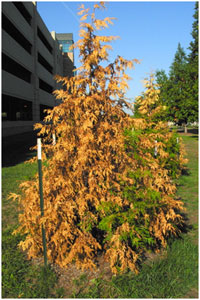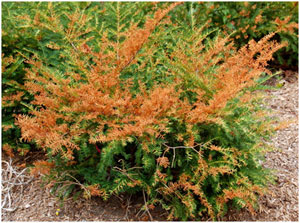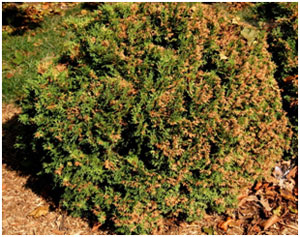Taking an environmentally sensitive approach to pest management
The Blast Furnace Summer of 2011 turned some Evergreens to Everbrowns
Published: October 1, 2011

Since the high temperature episode in July and August of 2011, I have observed extensive browning of certain evergreens. Some 8-foot-tall Green Giant arborvitae trees on campus are completely dead. Others show complete browning of individual branches or groups of branches. I have observed similar damage on other types of arborvitae and on yews. It seems likely that this damage is due to a combination of cool wet spring with little transition to the blast furnace conditions in mid-summer. In Columbia, we had 16 inches of rainfall between March 1 and July 1. This caused trees and shrubs to have shallow root systems and soft, drought-susceptible foliage. The blast furnace cranked up between July 19 and August 8. Table 1 shows weather data for this period at Sanborn Field in Columbia. The numbers are startling. The relative humidity on the hottest days was 50-60%, with maximum wind speeds greater than 20 MPH on two of the three hottest days. We only had 1.1 inches of rain in the month of July, only 0.2 inches in the 2 weeks prior to the major heat and only 0.22 inches during the hot spell itself. The temperature of bare soil at 4 inches got up to 95 degrees. Night temperatures in the 80s didn't help either.
I think that we did not realize how high the evaporative demand was and how low the soil moisture reserves were. As shown in the table, total estimated E.T. (Evapotranspiration from short crops) during the episode was 4.3 inches. Thus, over this 19 day period, we lost about 4 more inches of soil moisture than we regained from precipitation. Even if one realized that this was occurring, it would have been hard to keep up with irrigation.
Since the weather has cooled and we have gotten some rainfall, some of the affected plants appear to be recovering somewhat. However, it is likely that some branches have been completely killed, disfiguring the damaged plants beyond repair. It is also likely that the severe stress caused by the blast furnace summer of 2011 will make many plants susceptible to attack by diseases and insects that may affect them for several years.


| Table 1. Weather data from Sanborn Field in Columbia MO during the high temperature episode from July 16 to August 3. | |||||
| Month | Day | Precip | Max Temp | Max Wind Speed | E.T.* |
| 7 | 16 | 0 | 93.2 | 12.9 | 0.21 |
| 7 | 17 | 0 | 94.8 | 11.1 | 0.22 |
| 7 | 18 | 0 | 94.7 | 11.7 | 0.23 |
| 7 | 19 | 0 | 97.9 | 12.9 | 0.24 |
| 7 | 20 | 0 | 98.7 | 14.7 | 0.25 |
| 7 | 21 | 0 | 100.1 | 12.9 | 0.25 |
| 7 | 22 | 0 | 99.5 | 11.7 | 0.25 |
| 7 | 23 | 0 | 101.9 | 20.7 | 0.25 |
| 7 | 24 | 0 | 93.4 | 17.1 | 0.19 |
| 7 | 25 | 0 | 95 | 12.3 | 0.23 |
| 7 | 26 | 0 | 98.3 | 14.1 | 0.23 |
| 7 | 27 | 0 | 101.7 | 23.7 | 0.27 |
| 7 | 28 | 0.09 | 102.1 | 21.9 | 0.24 |
| 7 | 29 | 0 | 94.2 | 12.3 | 0.20 |
| 7 | 30 | 0.13 | 85.8 | 13.5 | 0.09 |
| 7 | 31 | 0 | 96.6 | 9.4 | 0.20 |
| 8 | 1 | 0 | 103.2 | 14.7 | 0.26 |
| 8 | 2 | 0 | 106.3 | 15.9 | 0.26 |
| 8 | 3 | 0 | 96.3 | 13.5 | 0.24 |
| total | 0.22 | 4.30 | |||
| *Estimated evaporative total evaporation from short crops like soybean. | |||||
Subscribe to receive similar articles sent directly to your inbox!
- Wildflowers for Summer Garden Color (07/10/23)
- Missouri Weather Update: Hit-and-Miss Precipitation (07/06/22)
- Summer Care of Reblooming Roses (06/27/22)
REVISED: September 29, 2015